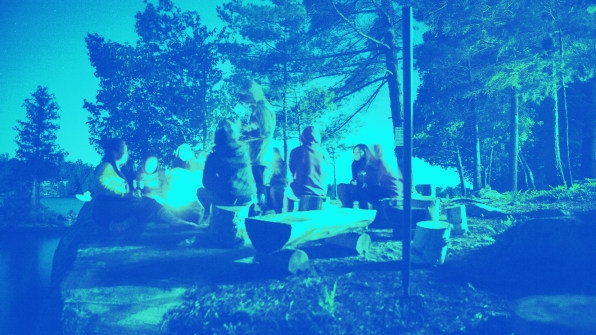Amid the isolation of new motherhood, I found solace in the communes of TikTok
At 22, I wanted a room of one’s own. At 32, I wanted a cacophony—anything but the deafening, lonely silence of pandemic isolation and new motherhood, a cosmic sucker punch.
It was during this time that I traded ambition for resignation, downloading TikTok to whittle away spare minutes between feedings, volume down so I could listen for the baby. I exacerbated my under-eye circles swiping through makeup tutorials; I watched home chefs stick their fingers in focaccia dough, smooth as the contours of my weary brain; and I fell in love with #CommuneTok, a variety of viral content where people live off the land and others’ kindness.
In the past two years, there’s been a wave of interest in alternative lifestyles, on and off the apps: Cole Trevino, aka @CommuneCowboy, who pans over mist floating on a nearby hill, a creek overlooking an abandoned bus, a dinner table set for 12, a fire in the wood stove. @julesamanita, who lifts a basket of foraged mushrooms to the camera under text explaining that they live with 70 adult residents and 13 kids at Virginia’s Twin Oaks, sharing income and governing collectively.
“We sustain ourselves by selling heirloom seeds, tofu, and hammocks,” they write, a verdant forest in the background. “Ask me anything.”
Mostly, the fantasy is white, youthful, and able-bodied, and there are no children in the background killing the pastoral vibe. Still, they exist off-screen—the nitty-gritty of parenting doesn’t lend itself to viral videos, but like farming, it’s a job best undertaken by the collective.
As my son grew from a doughy newborn to an expressive toddler, I thought of workdays in my pre-pandemic life, hustling to a computer screen with my $12 salad of unknown provenance. In theory, we have a choice between plugging a dam of emails or watching our labors sprout each spring. I thought of all the friends I had who’d recently escaped from New York to places where you could quarantine in sunlight.
“Touch grass,” the internet retort goes. How many pandemic-era mothers would sell their hair, Jo March-style, for that very privilege? More to the point: If a lonely, pandemic-era mother touches grass and no one but the preverbal child strapped on her back is there to witness it, does she exist at all?
I couldn’t imagine continuing down the same long, narrow tunnel of loss. First it was my coworkers, then my community, then my sense of self. There aren’t babies in these videos, but there’s room for them. If the side effect of parenting in unprecedented times is invisibility, I simply wanted to exist in some fresh air in a communal arrangement. Witness me, I thought, and tell me how you got your kid to sleep at night.
As my son grew from a doughy newborn to an expressive toddler, I thought of workdays in my pre-pandemic life, hustling to a computer screen with my $12 salad of unknown provenance.”
Abandoning the rat race for a less material, greener world is the sort of profound “discovery” made over and over again, around the world. There’s an asterisk on the whole of American history denoting people who would rather do things a different way, who look at how things are and say, “We can do better.”
SUNY Oneonta professor Mark Ferrara explores this in his book American Community, which follows the span of several intentional communities from colonial era to the present. In graduate school, he looked at depictions of utopia in literature, and it was a logical next step to find their real-life manifestations. After undertaking research for his book, he wound up moving into Ithaca’s EcoVillage, a cohousing community.
“I became interested in a historical overview of the 40 communities that I picked . . . which found a way to live so that people could share, to varying degrees, the resources of the community, and make sure that everybody enjoyed a certain level of well-being,” he said. “Rather than, for example, the kind of income inequality we see in the Gilded Age, in the late 19th century, and today.”
Then and now, childcare was enmeshed with income, resources, and support, or lack thereof. Our ability to parent hinges on the fulfillment of other needs—food on the table, secure housing, schools that are safe and functional.

Utopian idealism doesn’t feel specific to this moment because . . . it isn’t. Sometimes, thinking of my pastoral fantasies, I felt selfish. There had always been mothers terrified of missing work or finding a safe place to dock their kid during a shift—they had just flown entirely below my privileged twentysomething radar. Ferrara pointed to Skaneateles in upstate New York, an 1840s compound where residents raised children entirely collectively.
At San Diego’s Lomaland, a late 19th- and early 20th-century theosophical community, local children and orphans were educated on a de facto sliding scale, sometimes free, in alignment with their mission to “prepare destitute and homeless children to become workers for humanity.” Frequently, the attitude of these bygone groups was an ethos of larger responsibility—to better not just members, but mankind.
The Atomic Era family—Father, Mother, Sister, Brother—didn’t spring from the ether. It’s a trend that took root after assembly lines and wage labor dramatically transformed daily life and social structures, displacing multigenerational farming families. My fantasy is collective; somewhere, another mother is pining for her very own Ballerina Farm. There’s room for every archetype on the apps, but historically, the nuclear clan seems to have had better marketing.
I began perusing alternatives to my own reality on the website for the Foundation for Intentional Community. The listings run a wide gamut, and like groups of yore, some have families baked into their structures where others (subtly or not so subtly) exclude them. Only a few held the romantic allure of those TikToks. Instead, I found as many communities as there are varieties of loneliness—highly specific, usually in the shape of god or family.
It’s hard to see myself, my husband, or our unruly spawn worshipping with Sufis in Silver City, New Mexico. You can take mushrooms in a Brooklyn apartment; I should probably abstain. I’m still glad these exist (because not everything needs to be for everyone, although I’d argue that most of us could benefit from interdependence). If you leave the United States, you can become a part of collective experiments on other continents, places where it feels distinctly less counter to the prevailing culture: Israel’s kibbutz, Copenhagen’s Freetown Christiania.
In Northampton, Massachusetts, Yochai Gal and Sarah Jackson live with their young son at Rocky Hill, a cohousing community founded in 2006 with 28 private homes on a large, forested parcel of land. Through workdays, members of the community tend to common spaces and grounds, and prior to the pandemic, there were shared meals each Sunday night. When they relocated from the Boston area, Gal was already familiar with communal living—he’d grown up on a kibbutz—but the idea was more novel to Jackson.
Where Gal claims that, because of his upbringing, “the concept of intentional communities has never not been present,” Jackson grew up in “homogeneous, small-town New England: white, mostly Protestant,” she said. “It was very insular, and very common of American life in general: Everybody’s independent, you fend for yourself, you take care of yourself.”
As they established relationships with their community, they found an intergenerational environment where their son could roam from house to house, play in the fresh air, and form bonds with the other children up and down the cul-de-sacs. The pavement alone disrupts the perfect, tidy vision of the commune kale crops, but to me, it sounded intoxicating—permission to let down your defenses even momentarily.

“The free-range child is alive and well in cohousing because you can breathe that sigh of relief knowing there are so many other pairs of eyes,” Jackson said. She’s gotten calls to corroborate that her son is allowed to bum a popsicle from a neighbor’s fridge, and reports of his whereabouts by the sandbox.
“I feel like so many of my friends who are mothers right now have to micromanage their kids’ lives,” she said. “There’s so much fear, and there’s so little independence kids are granted. They get to have it here.”
After a traumatic incident with their son’s daycare, the aftermath of which made him stop sleeping entirely, their neighbors transformed from co-custodians of the shared Rocky Hill lawnmowers into a lifeline. Waking every 30 to 45 minutes, night after night, Jackson developed shingles; she and Gal were frayed, physically and otherwise.
“I remember people sent emails around and said, ‘They’re having a really hard time,’ and people started bringing food to our house, even people who frankly don’t participate that much in community. All of a sudden, the guy who I consider one of our grumpy neighbors shows up at the door . . . and is like, ‘Here’s some soup,’” Jackson said.
“[The community] organized meals for us, so we never had to cook,” Gal said. “They did our laundry. They walked our dog. They did everything for us, for weeks.”
Where cohousing might be the bridge between participating in “normal” workaday life and sharing resources like time and physical space, communes often form entire ecosystems unto themselves—living, working, and recreation. This is where many of the TikToks that initially seduced me fall: everything shared, including income and property.
At Alpha Farm in Deadwood, Oregon, residents cover their needs by working the area mail routes and growing food on the property. Kat Berrones is a mother of four who moved west from Austin with her two smallest children to live on the farm as a single parent. She visited her brother during the summer and by the fall, she’d settled there.
“It spoke to my soul,” she said. “I knew this is where I was meant to be; this was it.”
She’s the only parent in the commune currently, but Alpha—whose 93-year-old founder still lives there—was once home to several generations of kids. I stayed tuned to the farm’s Instagram account, where I’d initially reached out. Weeks after we spoke, there was a photo of a mealtime gathering over bright oilcloth-covered tables, a bunch of long-haired men and women smiling unselfconsciously and brandishing peace signs. The room is tidy and full of windows.
Throughout our call, the voices of Berrones’s two toddlers reverberated in the background, and she sounded as composed as any parent trying to multitask, pausing occasionally to resolve disputes (“Don’t push!”), to witness tricks. She described their days—filling water from the tank in the nearby farmhouse, hauling wood for a fire, morning hikes on the property’s 280 acres, and dinners with the rest of their cohort.
What is it that makes Alpha so magical, I asked? What made that decision, to uproot from Texas, so intuitive?
“When we were in Austin, we were in a home, of course, but it felt so isolated,” Berrones said. “I was super depressed, and it was hard to even want to do anything, and so cloistered.”
In her previous life, as a stay-at-home mom, she was often marooned inside four walls, struggling alone with her depression and responsibilities.
“There are some mornings where I’m like, ‘Damn it. I’ve got to walk all the way over here to go get wood to get the lodge warm, make cereal.’ It is a struggle, but I would rather do that than be at my house in Austin alone and depressed, doing nothing and wondering how much longer I can take it,” she said.
Alpha Farm and Rocky Hill, despite their lack of formal infrastructure for childcare or parents, represent a certain safety net. You can’t drown unnoticed when there are other people watching you. And the words Berrones used to describe her community—cozy, welcoming, accepting—feel distinctly opposite to the environments most mothers find outside their doors. You’ve never felt such a withering stare if you parent the wrong way in public; until you parent any way in public. You’ve never been judged so ferociously as when a train car finds your spawn obnoxious.
That permission to be human is what communal living, at its best, can offer. This stands to benefit anyone, parent or otherwise, especially those pushed to society’s edges. Living in such an arrangement entails an informal contract to treat each member like they matter—to acknowledge, at a minimum, that my existence depends on yours, and vice versa.
Even if they’ve bettered the lives of the people I spoke to, everyone also emphasized that these communities aren’t oases. They aren’t perfect; they aren’t cure-alls. They’re comprised of human beings, and that makeup will shape the overall experience. Maybe the reason well-known groups like those in Ferrara’s book ultimately shuttered is because a small but well-meaning commune is still made of imperfect people who can’t remedy larger social ills.
This was a necessary pin in whatever fantasy still floated through my daydreams. I would never live on the TikTok commune. If anything, I’d live in the one I could afford, wherever that was, with the people who’d already arrived there, whoever they were. Real life doesn’t fit inside a 30-second clip.
If we look back at the international communities, they’re always pushing back against the status quo, and as they do that, they’re offering another vision of what society could be like.”
“The way society is failing moms can’t be solved by cohousing,” Jackson said. It doesn’t provide healthcare; it doesn’t fix disparities in income, or maternal mortality, or street harassment. It’s just a group of people who value community, and who might share values like environmentalism or faith.
Cohousing communities often reflect larger issues, demographically: segregated, largely white, affluent. Communes like Alpha often skew very young and child-free, perhaps culturally alienating. Still, they’re positing an alternative. They’re arguing that we can scrap what hasn’t worked and try another way.
“If we look back at the international communities, they’re always pushing back against the status quo, and as they do that, they’re offering another vision of what society could be like,” Ferrara mused.
“I think that that might be a positive way to be looking at these intentional communities: not as a solution for all social ills,” he said. “‘If I just join EcoVillage, or if I just join this community, everything will be great.’” But we’re challenging the values of the existing order that we find exploitative. We’re offering a new model. Hopefully, society will eventually join us.”
Join me, I want to say. I have the pioneer’s itch to build something from scratch, even though I lack the capital and the time and the cohort of interested friends. In the intervening months—my child is almost 2—I’ve come a long way since my #CommuneTok summer. I’ve found remote work and a friend who lives in my building. I can no longer see a future in viral videos, and I wouldn’t trust myself to discern between species of mushroom.
The reality is, like most things, messier than the fantasy, and if we’re going to do it, it will be together—me, my son, and the other mothers alone behind a screen, determined to find a sunnier place.
Linnie Greene lives in Jersey City, New Jersey. You can find her work in outlets like The New York Times, Pitchfork, and Hobart, and on her website.
Fast Company , Read Full Story
(48)



